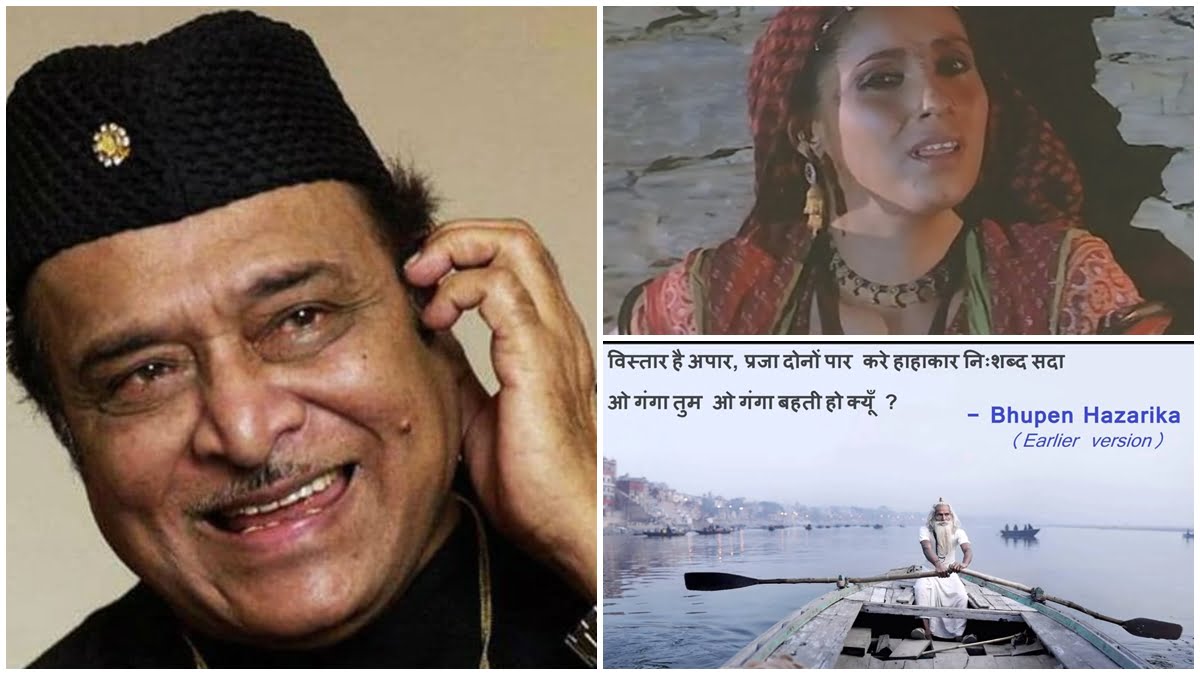Dr Bhupen Hazarika, popularly known as the ‘Bard of Brahmaputra’ held the nation in a spell with his melodious voice. His music has carried themes of love and romance, but his work is also a serious commentary on social and political issues. His extremely popular song ‘Dil Hoom Hoom Kare’ is often played in context of heartbreaks or its recent renditions carrying sensual undertones, all this while missing the connotations of helplessness and subjugation in women.
Dr Bhupen Hazarika, popularly known as the ‘Bard of Brahmaputra’ held the nation in a spell with his melodious voice. His music has carried themes of love and romance, but his work is also a serious commentary on social and political issues. His extremely popular song ‘Dil Hoom Hoom Kare’ is often played in context of heartbreaks or its recent renditions carrying sensual undertones, all this while missing the connotations of helplessness and subjugation in women.
Beginning with the song ‘O Ganga Behti Ho Kyun’, Dr Bhupen Hazarika implores the river Ganga to take action and give up her pacifist stance. River Ganga, a symbol of faith in the Hindu tradition and also a source of livelihood to the Indian subcontinent, her extensive basin accounts for one-fourth of India’s water resources and is home to more than 407 million Indians, or some one-third of India’s population. This religious, cultural and economic significance attached to Ganga attributes to the nurturing symbolism attached to it. In the lines,
Naitikta nashth hui,
manavta bharashth hui,
nirlajj bhav se behti ho kyun?
Dr Bhupen Hazarika is trying to incite a response from the River Ganga by using the word ‘Nirlajja’ which translates to ‘shamelessness’ in reference to her inaction. Throughout the song, Hazarika tries to show Ganga the true nature of man, the sinners, the wrongdoers, the corruption of morality; only for her to regain her fierceness. He wants Ganga to forgo her role as ‘Ganga Maa’ and fearlessly vanquish those who have breached her trust and plundered the earth.
Also read: Shailendra: Portraying Complex Realities Of Common Lives
Dr Bhupen Hazarika is calling upon Ganga to take action so she can reclaim her agency. He wants Ganga to express her hidden anger, thus de-normalising the relationship between women and silent acceptance of violence extensively.
Dr Bhupen Hazarika explores the shared experience of oppression women face under patriarchy. This relationship penetrates across barriers like caste, class and religion to a larger extent. This can be examined in relation to the movie Rudali by Kalpana Lajmi. This 1993 Hindi film revolves around the tragic life of Sanichari, who is unable to cry despite all the misfortunes that have befallen her. She meets Bhikni, an experienced rudali, who becomes Sanichari’s mother figure, later on helping her learn the tricks of the trade.
Dr Bhupen Hazarika was awarded the Best Music Director for the film. Bhupen Hazarika depicts women’s oppression and helplessness through the music of this film. This can be seen through the lens of the song, ‘Dil Hoom Hoom Kare’. The use of “hoom hoom’, instead of the over-romanticized ‘dhak dhak’ speaks volumes about the silent subjugation of women. As pointed out by Jayosmita Ganguly in her article ‘Film Through a Song: ‘Dil Hoom Hoom Kare’, the use of hoom hoom is to symbolize the silent lives of women, whose tears are never shed, no outward manifestation of their grief is to be seen, yet their hearts goes ‘hoom hoom’, heard by no one. Throughout the song Sanichari (Dimple Kapadia) can be seen silently chasing a shadow, without shedding a tear. The uttering of the word hoom, the enunciating of ‘m’ presses Sanichari’s lips together, closing her mouth, in turn silencing her even while she is expressing her loneliness and grief. Through the brilliant composition and lyrics, the protagonist constantly brings up her grief but she is never allowed to burst open or have a catharsis.
Also read: Anaahat (2003): Niyog Pratha & Women’s Sexual Freedom In Amol Palekar’s Film
Dr Bhupen Hazarika’s body of work is diverse, his songs often provide a space for the female narrative. The history of women’s oppression and discrimination is a constant theme in Hazarika’s work. Dr Bhupen Hazarika uses his work as both a mirror of the society, reflecting the reality, at the same time questioning the hegemonic dominance.
Dr Bhupen Hazarika’s body of work is diverse, his songs often provide a space for the female narrative. The history of women’s oppression and discrimination is a constant theme in Hazarika’s work. Dr Bhupen Hazarika uses his work as both a mirror of the society, reflecting the reality, at the same time questioning the hegemonic dominance. Be it inciting Ganga to act and react or depicting the silent lives of women under patriarchy in Rudali, he excellently mirrors the subaltern, making space for them to reclaim their agency.
Rutba Iqbal is a student of literature from Jamia Millia Islamia and she is from Srinagar, Jammu and Kashmir. Follow her on Instagram.





Which patriarchy are you talking about?Houses are ruled by mothers-in-law, women are privileged to spend a man’s earnings, always preferred in divorce courts, handed child custody in the majority of cases, less jail time for the same crimes committed by men, an accusation by a woman is seen as evidence, shelters only for female victims of domestic violence, media rarely covers men’s issues, seats in buses and metros are reserved for women, majority of homicide victims are men, majority of workplace deaths are men, majority of homeless are men, majority of funding is spent on women’s health, men’s life savings are spent in alimony and child support payments, even in two income families men bear the monetary burden, men face mandatory conscription, men are victims of paternity fraud, you name it.